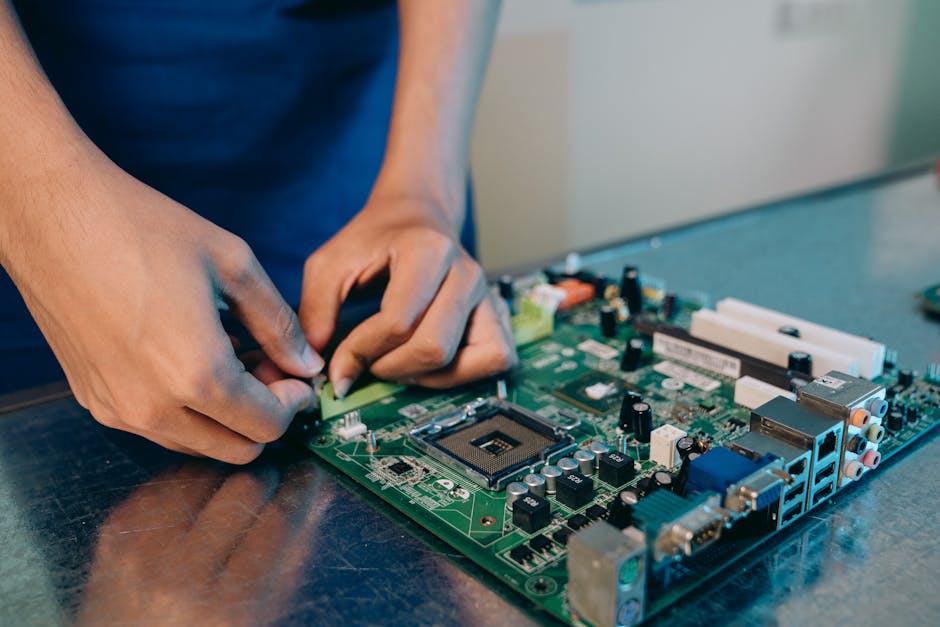Dans John Schulman: Latest Updates and Analysis
John Schulman quitte Anthropic : Un départ stratégique dans le secteur de l’IA

John Schulman, cofondateur d’OpenAI et ancien chercheur d’Anthropic, quitte la startup d’intelligence artificielle. Son départ marque un tournant crucial dans le secteur de l’IA, où Anthropic est devenu un acteur majeur. Cette décision soulève des interrogations sur l’avenir de l’entreprise et les nouvelles ambitions de Schulman.
Un départ qui marque l’évolution d’Anthropic.
John Schulman avait rejoint Anthropic en août dernier après avoir quitté OpenAI. Il souhaitait alors se recentrer sur les enjeux techniques de l’alignement de l’intelligence artificielle. Son expertise était précieuse pour la startup, qui cherche à développer des modèles toujours plus performants et sécurisés.
Anthropic, souvent présenté comme un rival direct d’OpenAI, connaît une croissance fulgurante. En effet, son chiffre d’affaires annualisé atteint environ 875 millions de dollars. De plus, la startup collabore avec des plateformes cloud telles qu’Amazon Web Services pour proposer ses modèles à grande échelle. Le départ de Schulman intervient donc à un moment clé pour l’entreprise, qui doit continuer à innover face à une concurrence féroce.
Une décision stratégique pour l’expert en IA.
Schulman, reconnu pour ses contributions majeures en intelligence artificielle, pourrait chercher de nouvelles opportunités dans le domaine. D’ailleurs, son départ montre qu’il souhaite explorer d’autres axes de recherche ou lancer de nouveaux projets. Son expertise sur l’alignement de l’IA reste un sujet central dans le développement des modèles actuels.
De plus, ce départ soulève des interrogations sur ses prochaines ambitions. Rejoindra-t-il une autre entreprise spécialisée dans l’IA ou lancera-t-il sa propre initiative ? Quoi qu’il en soit, son influence dans le secteur reste importante. OpenAI et Anthropic ont déjà façonné l’avenir de l’intelligence artificielle, et Schulman pourrait encore jouer un rôle clé dans son évolution.
Avec un marché de l’IA en pleine expansion, Anthropic doit désormais prouver sa capacité à se développer sans Schulman. La startup continue de renforcer son offre en collaborant avec des partenaires stratégiques de premier plan. D’ailleurs, ses modèles d’intelligence artificielle sont déjà largement utilisés dans de nombreux services.
Cependant, la concurrence avec OpenAI et d’autres acteurs majeurs comme Google DeepMind s’intensifie. Anthropic doit donc maintenir son avance technologique sur le marché pour rester un leader du secteur. Le départ de Schulman pourrait entraîner des réajustements internes, mais l’entreprise semble prête à poursuivre son ascension.
Le départ de John Schulman marque un tournant pour Anthropic et pour l’industrie de l’intelligence artificielle. Cette décision ouvre la voie à de nouvelles dynamiques, aussi bien pour l’entreprise que pour l’expert lui-même. D’ailleurs, son influence pourrait se faire sentir dans d’autres projets à venir.
Alors que l’IA continue de transformer le monde, les choix de figures comme Schulman restent déterminants. Son prochain mouvement sera suivi de près par l’ensemble du secteur technologique. L’avenir de l’intelligence artificielle est en pleine mutation, et chaque acteur joue un rôle crucial dans cette révolution.
Graphs, in which objects and their relations are represented as nodes (or vertices) and edges (or links) between pairs of nodes, are ubiquitous in com...
With DeepSeek becoming the world’s leading app in no time, ByteDance, the corporation behind TikTok, has now released a research paper on its new video ge...
Keir Starmer zappe le sommet de l’IA à Paris, le Royaume-Uni perd-il en influence ?

Le Premier ministre britannique Keir Starmer a pris une décision qui pourrait faire des vagues sur la scène internationale. Il ne participera pas au Sommet international sur l’IA, prévu les 10 et 11 février à Paris. Pourtant, cet événement réunira des dirigeants mondiaux, dont Emmanuel Macron, Narendra Modi et JD Vance, vice-président américain.
L’absence de Keir Starmer soulève des questions : privilégie-t-il les affaires nationales ou prend-il le risque d’affaiblir la position du Royaume-Uni dans la course à l’IA ?
Selon des information proches du gouvernement, Starmer a choisi de se concentrer sur des priorités internes. Pendant la première journée du sommet, il effectuera une visite consacrée au logement, un dossier sensible au Royaume-Uni. Ensuite, il participera à un vote crucial à la Chambre des communes sur le projet de loi relatif à l’immigration.
Cette décision s’inscrit dans une stratégie visant à répondre aux critiques selon lesquelles il passe trop de temps à l’étranger au détriment des affaires domestiques.
Un risque diplomatique face aux alliés internationaux.
En snobant le sommet, Starmer pourrait contrarier Emmanuel Macron et Narendra Modi, qui coorganisent l’événement. Ce rendez-vous est considéré comme un moment clé de la présidence française.
Macron mise sur cette conférence pour asseoir son influence et promouvoir une IA responsable. Le Premier ministre britannique manquera également une occasion de discuter avec des figures influentes du secteur technologique, notamment Elon Musk, dont la présence est attendue.
Le sommet de Paris vise à poser les bases d’un cadre international pour un développement responsable de l’IA. Parmi les sujets clés figurent la question des énergies propres pour alimenter les infrastructures d’IA et les impacts sur le marché du travail. Ce forum s’inscrit dans la continuité du sommet organisé en 2023 à Bletchley Park par Rishi Sunak, alors Premier ministre.
Les conservateurs n’ont pas tardé à réagir. Alan Mak, secrétaire d’État à la Science et à l’Innovation, accuse Starmer de mettre en péril le leadership britannique en matière d’IA. Il rappelle que le Royaume-Uni a accueilli le premier sommet sur la sécurité de l’IA sous l’égide de Rishi Sunak. Cet événement avait permis de publier la première déclaration internationale sur les risques liés aux algorithmes avancés.
Malgré son absence, Starmer assure que le Royaume-Uni reste un acteur majeur dans le domaine de l’IA. Un porte-parole de Downing Street a déclaré : « Le Premier ministre croit fermement au potentiel économique de cette technologie. Notre plan d’action sur l’IA vise à maximiser l’impact du Royaume-Uni en matière de croissance et d’innovation. ».
En ne se rendant pas à Paris, Keir Starmer privilégie les affaires internes, mais risque de perdre une occasion d’influencer les débats mondiaux sur l’intelligence artificielle. Son choix reflète-t-il une réelle stratégie nationale ou un manque d’ambition diplomatique ? Seul l’avenir dira si cette absence sera perçue comme un acte pragmatique ou une erreur politique.
As an illustrative case study, we applied the framework to a dermatology model, which utilizes a convolutional neural network similar to that describe...
Alibaba dévoile Qwen [website] Max, un modèle d’IA qui vient bousculer l’équilibre du secteur. Face à DeepSeek V3/R1 et GPT-4o, il affiche des performances ...
Today the 2024 March Meeting of the American Physical Society (APS) kicks off in Minneapolis, MN.
A premier conference on topics ranging across physi...
[VIDÉO] Choc dans l’IA : Qwen 2.5 Max surclasse déjà les géants ?
![[VIDÉO] Choc dans l’IA : Qwen 2.5 Max surclasse déjà les géants ?](/images/ai-tech/picture/image_265.jpg)
Alibaba dévoile Qwen [website] Max, un modèle d’IA qui vient bousculer l’équilibre du secteur. Face à DeepSeek V3/R1 et GPT-4o, il affiche des performances qui pourraient bien rebattre les cartes et redéfinir la course à l’IA.
Ce modèle repose sur une architecture MoE (Mixture of Experts), une technologie qui active uniquement les neurones nécessaires en fonction des tâches. Résultat : une meilleure gestion des ressources, une exécution plus rapide et une précision accrue. En s’appuyant sur un entraînement massif de plus de 20 000 milliards de tokens, il repousse encore plus loin les capacités des modèles linguistiques.
Mais ce qui distingue véritablement Qwen [website] Max, c’est son accessibilité. Contrairement à d’autres solutions du marché, il est disponible gratuitement via le Qwen Chat. Une ouverture qui démocratise une technologie avancée et la met à portée de tous, des curieux aux professionnels de l’IA.
Pour les performances de Qwen [website] Max et voir comment l’utiliser pour explorer toutes ses fonctionnalités, on vous invite à regarder la vidéo jusqu’à la fin. N’hésitez pas non plus à vous abonner à notre chaîne pour suivre avec nous les dernières avancées technologiques et rester informé des prochaines innovations en IA.
OpenAI cofounder John Schulman, who joined Anthropic last year, departed from the enterprise in just five months. He is reportedly joining former OpenAI ...
In “Domain-specific optimization and diverse evaluation of self-supervised models for histopathology”, we showed that self-supervised...
TakeMe2Space, a Hyderabad-based space-tech startup, is aiming to make space more accessible by launching India’s first AI-driven space laboratory. Fou...
Market Impact Analysis
Market Growth Trend
| 2018 | 2019 | 2020 | 2021 | 2022 | 2023 | 2024 |
|---|---|---|---|---|---|---|
| 23.1% | 27.8% | 29.2% | 32.4% | 34.2% | 35.2% | 35.6% |
Quarterly Growth Rate
| Q1 2024 | Q2 2024 | Q3 2024 | Q4 2024 |
|---|---|---|---|
| 32.5% | 34.8% | 36.2% | 35.6% |
Market Segments and Growth Drivers
| Segment | Market Share | Growth Rate |
|---|---|---|
| Machine Learning | 29% | 38.4% |
| Computer Vision | 18% | 35.7% |
| Natural Language Processing | 24% | 41.5% |
| Robotics | 15% | 22.3% |
| Other AI Technologies | 14% | 31.8% |
Technology Maturity Curve
Different technologies within the ecosystem are at varying stages of maturity:
Competitive Landscape Analysis
| Company | Market Share |
|---|---|
| Google AI | 18.3% |
| Microsoft AI | 15.7% |
| IBM Watson | 11.2% |
| Amazon AI | 9.8% |
| OpenAI | 8.4% |
Future Outlook and Predictions
The Dans John Schulman landscape is evolving rapidly, driven by technological advancements, changing threat vectors, and shifting business requirements. Based on current trends and expert analyses, we can anticipate several significant developments across different time horizons:
Year-by-Year Technology Evolution
Based on current trajectory and expert analyses, we can project the following development timeline:
Technology Maturity Curve
Different technologies within the ecosystem are at varying stages of maturity, influencing adoption timelines and investment priorities:
Innovation Trigger
- Generative AI for specialized domains
- Blockchain for supply chain verification
Peak of Inflated Expectations
- Digital twins for business processes
- Quantum-resistant cryptography
Trough of Disillusionment
- Consumer AR/VR applications
- General-purpose blockchain
Slope of Enlightenment
- AI-driven analytics
- Edge computing
Plateau of Productivity
- Cloud infrastructure
- Mobile applications
Technology Evolution Timeline
- Improved generative models
- specialized AI applications
- AI-human collaboration systems
- multimodal AI platforms
- General AI capabilities
- AI-driven scientific breakthroughs
Expert Perspectives
Leading experts in the ai tech sector provide diverse perspectives on how the landscape will evolve over the coming years:
"The next frontier is AI systems that can reason across modalities and domains with minimal human guidance."
— AI Researcher
"Organizations that develop effective AI governance frameworks will gain competitive advantage."
— Industry Analyst
"The AI talent gap remains a critical barrier to implementation for most enterprises."
— Chief AI Officer
Areas of Expert Consensus
- Acceleration of Innovation: The pace of technological evolution will continue to increase
- Practical Integration: Focus will shift from proof-of-concept to operational deployment
- Human-Technology Partnership: Most effective implementations will optimize human-machine collaboration
- Regulatory Influence: Regulatory frameworks will increasingly shape technology development
Short-Term Outlook (1-2 Years)
In the immediate future, organizations will focus on implementing and optimizing currently available technologies to address pressing ai tech challenges:
- Improved generative models
- specialized AI applications
- enhanced AI ethics frameworks
These developments will be characterized by incremental improvements to existing frameworks rather than revolutionary changes, with emphasis on practical deployment and measurable outcomes.
Mid-Term Outlook (3-5 Years)
As technologies mature and organizations adapt, more substantial transformations will emerge in how security is approached and implemented:
- AI-human collaboration systems
- multimodal AI platforms
- democratized AI development
This period will see significant changes in security architecture and operational models, with increasing automation and integration between previously siloed security functions. Organizations will shift from reactive to proactive security postures.
Long-Term Outlook (5+ Years)
Looking further ahead, more fundamental shifts will reshape how cybersecurity is conceptualized and implemented across digital ecosystems:
- General AI capabilities
- AI-driven scientific breakthroughs
- new computing paradigms
These long-term developments will likely require significant technical breakthroughs, new regulatory frameworks, and evolution in how organizations approach security as a fundamental business function rather than a technical discipline.
Key Risk Factors and Uncertainties
Several critical factors could significantly impact the trajectory of ai tech evolution:
Organizations should monitor these factors closely and develop contingency strategies to mitigate potential negative impacts on technology implementation timelines.
Alternative Future Scenarios
The evolution of technology can follow different paths depending on various factors including regulatory developments, investment trends, technological breakthroughs, and market adoption. We analyze three potential scenarios:
Optimistic Scenario
Responsible AI driving innovation while minimizing societal disruption
Key Drivers: Supportive regulatory environment, significant research breakthroughs, strong market incentives, and rapid user adoption.
Probability: 25-30%
Base Case Scenario
Incremental adoption with mixed societal impacts and ongoing ethical challenges
Key Drivers: Balanced regulatory approach, steady technological progress, and selective implementation based on clear ROI.
Probability: 50-60%
Conservative Scenario
Technical and ethical barriers creating significant implementation challenges
Key Drivers: Restrictive regulations, technical limitations, implementation challenges, and risk-averse organizational cultures.
Probability: 15-20%
Scenario Comparison Matrix
| Factor | Optimistic | Base Case | Conservative |
|---|---|---|---|
| Implementation Timeline | Accelerated | Steady | Delayed |
| Market Adoption | Widespread | Selective | Limited |
| Technology Evolution | Rapid | Progressive | Incremental |
| Regulatory Environment | Supportive | Balanced | Restrictive |
| Business Impact | Transformative | Significant | Modest |
Transformational Impact
Redefinition of knowledge work, automation of creative processes. This evolution will necessitate significant changes in organizational structures, talent development, and strategic planning processes.
The convergence of multiple technological trends—including artificial intelligence, quantum computing, and ubiquitous connectivity—will create both unprecedented security challenges and innovative defensive capabilities.
Implementation Challenges
Ethical concerns, computing resource limitations, talent shortages. Organizations will need to develop comprehensive change management strategies to successfully navigate these transitions.
Regulatory uncertainty, particularly around emerging technologies like AI in security applications, will require flexible security architectures that can adapt to evolving compliance requirements.
Key Innovations to Watch
Multimodal learning, resource-efficient AI, transparent decision systems. Organizations should monitor these developments closely to maintain competitive advantages and effective security postures.
Strategic investments in research partnerships, technology pilots, and talent development will position forward-thinking organizations to leverage these innovations early in their development cycle.
Technical Glossary
Key technical terms and definitions to help understand the technologies discussed in this article.
Understanding the following technical concepts is essential for grasping the full implications of the security threats and defensive measures discussed in this article. These definitions provide context for both technical and non-technical readers.
platform intermediate
algorithm intermediate
API beginner
 How APIs enable communication between different software systems
How APIs enable communication between different software systems

